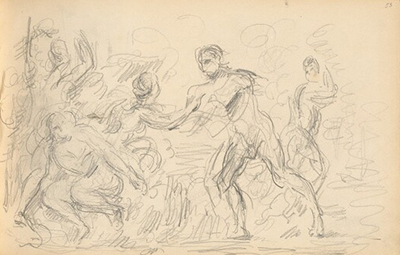 Buy Art Prints Now
Buy Art Prints Nowfrom Amazon
* As an Amazon Associate, and partner with Google Adsense and Ezoic, I earn from qualifying purchases.
This expressive drawing features at least five figures as Cezanne uses loose, quick strokes of graphite in order to create something quite complex. There are no amendments but just extra lines to realign elements as he put the different forms together.
The energy of this artwork will remind some of a number of Renoir paintings during a particular period in his career. The foreground and background merge together somewhat here because Cezanne does not vary the strength of his strokes of graphite. This unfortunately means that picking out detail is quite difficult, with only one figure being immediately noticeable. The strong male figure stands just to the right of centre and has darker likes which help us to notice him first of all. His thigh muscles are particularly prominent and there is also shading below his shoulder and under his chin to form shadows. The remaining figures are all in a seemingly random and diverse set of poses, be it squatting, reaching out or other. There also appears to be elements of nature involved too, with flourishes of line in between each figure, though it is impossible to determine whether we are looking at grass, trees or some other type of shrubbery.
Judgement of Paris was a memorable painting from this artist's career and there are clear similarities with the drawing found in front of us here. There does not appear to be any account of The Amorous Shepherd from his list of paintings, and so we are unsure about that comparison. It is more than possible that this drawing was intended as preparation because a good number of those within this sketchbook were entirely for that purpose. Others seemed to be to remember a moment or an angle, whilst out walking in the countryside or even at home with his wife and family.
The drawing was a part of a large sketchbook, one of many used by Cezanne during his career. The items within this particular one date from the 1870s to the 1890s and feature a good mixture of different genres. There are full length portraits such as this one, as well as a number of shoulder length depictions of his mother and son. There are also studies of sculptures from his time travelling around some of the major art galleries and museums of France, most frequently the Louvre. There were also visual records of his trips around the French countryside, something that seemed to calm down a complicated character and also inspire some of the best work of his career. We are all aware of famous Cezanne paintings such as Mont Sainte-Victoire, The Bay of Marseille seen from L'Estaque and Banks of the Marne, but before they were possible he would have to have spent hour and hour perfected his understanding of landscape drawing and painting.



